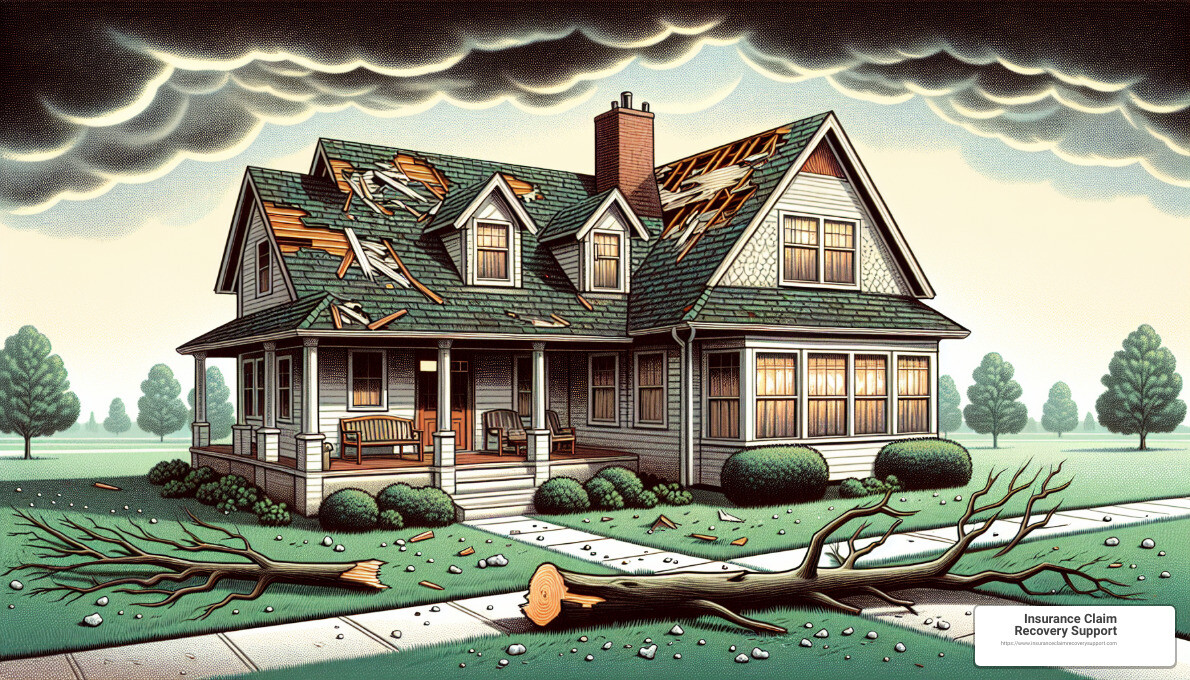Boldly navigating the hail damage roof insurance claim maze can save you time and stress. Understanding your insurance policy, documenting damage accurately, and knowing when to seek professional help are key steps in securing the funds needed for roof repairs.
Hailstorms can wreak havoc on roofs, leading to significant damage that might require extensive repairs or even a complete replacement. As a property owner, especially in sectors like healthcare, education, or hospitality, ensuring your building’s integrity is critical. Filing an insurance claim may seem daunting, but it’s necessary to mitigate losses and restore safety.
The process starts by identifying the damage right after the event, followed by contacting your insurance provider to initiate a claim. However, it’s common for claims to be underpaid or denied, leaving property owners frustrated and financially strained. Here, we address the primary concerns you may face and outline the actionable steps to file your claim effectively.

Understanding Hail Damage and Insurance Coverage
When a hailstorm hits, the size of the hail, the materials used in your roof, and the specifics of your insurance coverage all play critical roles in determining whether your hail damage roof insurance claim will be successful. Let’s break down these elements to help you understand how they impact your claim.
Hail Size
Hail can range from pea-sized (about 1/4 inch) to as large as a grapefruit (4 inches or more). Generally, hail must be at least 1 inch in diameter to cause damage to asphalt shingles or other common roofing materials. Larger hail can damage even the most robust roofing materials and lead to more significant insurance claims.
Roof Materials
Different roofing materials have varying levels of resistance to hail damage:
– Asphalt Shingles: Most common but vary in quality and hail resistance.
– Metal Roofs: Highly durable and more resistant to hail.
– Tile Roofs: Can crack with large hail but generally offer good resistance.
The type of material not only affects the likelihood of damage but also plays a part in insurance coverage limitations and payouts.
Covered Perils
Most homeowner’s insurance policies cover “perils” such as hail damage. However, the extent of the coverage can vary significantly. It’s crucial to know whether your policy is an “all risks” policy (covering all perils unless explicitly excluded) or a “named perils” policy (covering only those perils listed in the policy).
Cosmetic vs. Functional Damage
Insurance companies often distinguish between cosmetic damage (which affects the appearance but not the functionality of the roof) and functional damage (which impairs the roof’s ability to keep water out). Many policies do not cover cosmetic damage, which can lead to disputes over the nature of the hail damage.
Understanding these factors is crucial when preparing to file a hail damage roof insurance claim. Knowing the specifics of your roof’s materials, the details of hail impact, and the nuances of your insurance coverage can equip you with the information needed to navigate the claims process more effectively. Next, we will look at how to properly document and assess the damage to ensure your claim is thorough and backed by solid evidence.
The Claim Filing Process for Hail Damage in Texas
When you’re dealing with roof damage from a hail storm in Texas, understanding the claim filing process is essential. Let’s walk through the key steps: the statute of limitations, the importance of thorough documentation, how to contact your insurance, and what happens during the initial assessment.
Statute of Limitations
In Texas, you have two years from the date of the hailstorm to file your hail damage roof insurance claim. This period allows you to assess the damage, gather necessary documentation, and file a claim. However, it’s best to act quickly to avoid complications related to fading memories or lost evidence.
Documentation
Documenting the damage thoroughly is crucial. Take clear, detailed photos of your roof from various angles, showing all areas affected by the hail. Note the date of the storm and any repairs or assessments done immediately after. Keep all receipts and records of conversations with roofing professionals or insurance representatives. This documentation will be essential for supporting your claim.
Contacting Your Insurance
Once your documentation is ready, contact your insurance company to report the hail damage. Most insurers require you to fill out a claim form—be detailed and precise. Include all the documentation you’ve gathered to paint a clear picture of the damage. This step is crucial, as missing or vague information can delay the process.
Initial Assessment
After you file your claim, your insurance company will send an adjuster to assess the damage firsthand. This visit is a critical part of the process. Be present during the assessment so you can guide the adjuster through the damage and ensure they note all relevant details. Share your documentation with the adjuster to help substantiate your claim.
Being proactive and well-prepared can significantly influence the ease and success of your hail damage roof insurance claim. The goal is to ensure that you receive the fair value for the damages to restore your roof to its pre-storm condition. Following these steps diligently will help you navigate the claim process effectively in Texas. Next, we will explore how to identify and document specific types of hail damage to your roof.
Identifying and Documenting Roof Hail Damage
Identifying and documenting the extent of hail damage on your roof is crucial for a successful hail damage roof insurance claim. This section will guide you on how to assess and record damage to metal pieces, shingles, vents, gutters, and identify any collateral damage around your property.
Metal Pieces
Metal components such as flashing, vents, and gutters are highly susceptible to hail damage. Look for:
- Dents and Dings: These are the most common forms of damage and can be easily spotted.
- Misalignment: Hail can knock these pieces out of alignment, affecting their functionality.
- Punctures or Holes: Less common but more severe, these damages can lead to leaks.

Shingles
Shingles are your roof’s first defense and often bear the brunt of hail impacts. When inspecting shingles, check for:
- Granule Loss: Hail can strip the protective granule layer off shingles, exposing the asphalt.
- Cracks or Splits: Look for any breaks in the shingles which can lead to water infiltration.
- Missing Shingles: High-intensity hail can dislodge shingles completely.
Documenting these damages with clear, close-up photographs is essential. Ensure each photo is timestamped to avoid any disputes during the claim process.
Vents and Gutters
Vents and gutters can also indicate the level of hail impact. Inspect for:
- Indentations on Vents: These can compromise the vent’s structure and functionality.
- Gutter Deformation: Check for bends or breaks in the gutter lines which can impede water flow.
Collateral Damage
Finally, assess the area around your home for collateral damage which can support your claim:
- Damaged Yard Items: Look for dents on items like air conditioning units and outdoor furniture.
- Window Damage: Hail can crack or break windows and damage frames.
- Damage to Cars and Other Property: Document any dents and damages to cars parked outside.
For each type of damage:
- Take Photos: Capture multiple angles and distances to provide a comprehensive view.
- Record Videos: A walkthrough video can help the adjuster understand the extent and location of the damage.
- Maintain a Written Log: Include dates, descriptions, and any immediate actions taken (like covering broken windows).
By thoroughly documenting the hail damage, you enhance your ability to substantiate your claim with the insurance adjuster. This detailed evidence is vital in proving the extent of the damage and ensuring a fair assessment by the insurance company.
Next, we’ll discuss how to navigate the complexities if your hail damage claim is initially denied.
Navigating a Denied Hail Damage Claim
When you file a hail damage roof insurance claim and it gets denied, it can feel like a heavy blow. However, you have several options to contest the decision and potentially turn the situation around. Here’s how to navigate through a denied claim effectively:
Policy Review
First, carefully review your insurance policy. Understand the specifics of what is covered and what is not. Look for any clauses related to hail damage and the types of damage (cosmetic vs. structural) that are covered. This review helps you pinpoint any discrepancies or misunderstandings in the denial of your claim.
Appeal Process
If you believe your claim was wrongfully denied based on your policy coverage, you can file an appeal with your insurance company. This process usually involves submitting a formal letter outlining why you believe the denial was incorrect, supported by evidence such as photos of the damage and your detailed documentation.
Hiring a Public Adjuster
Consider hiring a public adjuster if the appeal process becomes overwhelming or if you’re not making the desired progress. Public adjusters specialize in dealing with insurance claims and can offer a second opinion on the damage and the fairness of the insurance company’s decision. They work on your behalf to negotiate with the insurance company and often have a deeper understanding of insurance laws and policies.
Legal Options
As a last resort, you might consider legal action. Consult with an attorney who specializes in insurance law to discuss your case. They can provide legal advice on how to proceed and represent you in court if necessary. Legal action can be time-consuming and costly, so it should be considered carefully.
By understanding your policy, utilizing the appeals process, possibly hiring a public adjuster, and knowing your legal options, you can better navigate the complexities of a denied hail damage roof insurance claim. Persistence is key, and understanding your rights can empower you to fight back effectively.
In the next section, we’ll explore strategies to maximize your claim’s potential, ensuring you get the compensation you deserve for roof repairs or replacement.
Maximizing Your Claim: Tips and Strategies
Navigating hail damage roof insurance claim can be tricky, but with the right strategies, you can make sure you get the best possible outcome. Here are some essential tips and strategies to help you maximize your insurance claim:
Replacement Cost Value vs. Actual Cash Value
Understanding the difference between Replacement Cost Value (RCV) and Actual Cash Value (ACV) is crucial:
-
Replacement Cost Value (RCV): This policy covers the cost to replace your damaged roof without considering depreciation. It means you get enough funds to replace your roof with a similar new one.
-
Actual Cash Value (ACV): This policy provides you with a payout that reflects the roof’s depreciated value. Essentially, you get the roof’s current worth, which might not be enough to cover a full replacement.
For those looking to fully restore their property, opting for RCV coverage is generally more beneficial, even though it might come with higher premiums.
Supplementing Your Claim
If the initial payout offer from your insurance seems low, you might need to supplement your claim. Here’s how:
- Gather Documentation: Collect all receipts, detailed photographs of the damage, and written estimates from contractors.
- Provide Detailed Estimates: Show estimates that outline the scope of work and the cost of materials and labor. This helps justify the need for a higher payout.
Hiring a Reputable Contractor
Choosing the right contractor is pivotal:
- Check Credentials: Ensure the contractor is licensed, insured, and has good reviews or testimonials.
- Experience with Insurance Claims: A contractor experienced in dealing with insurance claims can provide valuable assistance and insight throughout the process.
Preparing for the Adjuster’s Visit
When the insurance adjuster visits to assess the damage, being well-prepared can influence the outcome of your claim:
- Documentation Ready: Have all your documentation handy — photos, estimates, and any reports from roofing experts.
- Be Present: Walk through the damage with the adjuster, pointing out all areas of concern. This helps ensure nothing gets overlooked.
By following these strategies, you can effectively maximize your hail damage roof insurance claim. Taking these steps not only helps ensure that you receive fair compensation but also that your roof repair or replacement is handled smoothly and efficiently.
Next, we’ll discuss some of the most common questions homeowners have about hail damage and insurance claims.
Conclusion
Navigating the complexities of a hail damage roof insurance claim can be daunting. That’s where Insurance Claim Recovery Support comes in, your ally in this intricate process. Our expertise and dedication to your case ensure that you are not left to handle the challenges alone.
Insurance Claim Recovery Support specializes in helping homeowners like you understand their rights and the steps necessary to secure a fair claim settlement. We work tirelessly to ensure that every detail of your claim is meticulously documented and presented, maximizing the possibility of a favorable outcome.
Our team is skilled in negotiating with insurance companies, leveraging our deep understanding of insurance policies and hail damage specifics. This expertise is crucial, especially when claims are initially denied or underpaid. We stand by your side, ready to advocate for your rights and ensure that you receive the compensation you deserve to restore your home.
When you face roof damage due to hail, having a knowledgeable partner can make a significant difference. Insurance Claim Recovery Support is here to guide you through every step, from initial damage assessment to final settlement, ensuring that your claim is handled professionally and promptly.
Let’s address some of the most common questions homeowners have about hail damage and insurance claims, ensuring you’re fully prepared for any weather-related challenges that may come your way.
Frequently Asked Questions about Hail Damage Roof Insurance Claims
Navigating the complexities of hail damage roof insurance claims can raise several questions. We’ve compiled answers to some of the most frequently asked questions to help you understand the process better.
What size hail can cause roof damage?
The size of hail necessary to damage a roof varies, but generally, hail must be at least 1 inch in diameter (about the size of a quarter) to cause significant damage to roofing materials. Larger hailstones can cause more severe damage, including dents on metal surfaces, cracks in shingles, or even punctures. It’s important to inspect your roof after any hailstorm, regardless of hail size, to assess potential damage.
How long do I have to file a hail damage claim in Texas?
In Texas, the statute of limitations for filing a hail damage claim on your roof is typically one year from the date of the storm that caused the damage. However, it’s advisable to file your claim as soon as possible. Prompt filing not only helps in quicker processing but also in mitigating further damage to your property.
Can a hail damage claim increase my home insurance premiums?
Filing a single hail damage claim may not necessarily increase your home insurance premiums, especially if it is an isolated event. However, multiple claims within a short period or claims that indicate a high risk of future losses (such as living in a hail-prone area) might affect your rates. Insurance companies assess risk differently, so it’s wise to discuss how a claim might impact your premiums with your insurer.
For more detailed guidance on navigating the complexities of a hail damage roof insurance claim, or if you need help after a claim denial, visit our service page at Insurance Claim Recovery Support. We’re here to ensure that you receive the full benefits your policy entitles you to, with no recovery, no fee.








